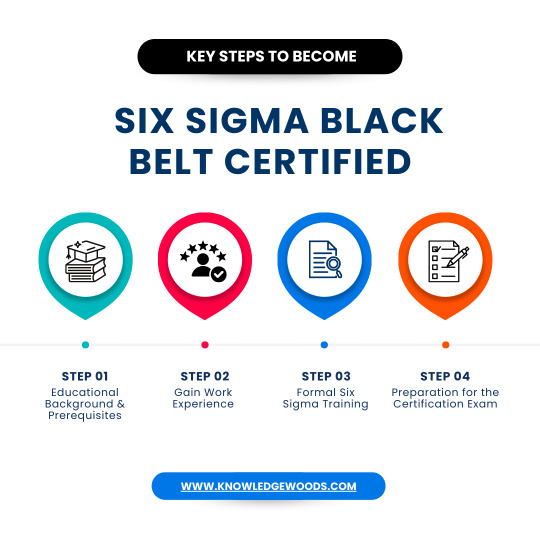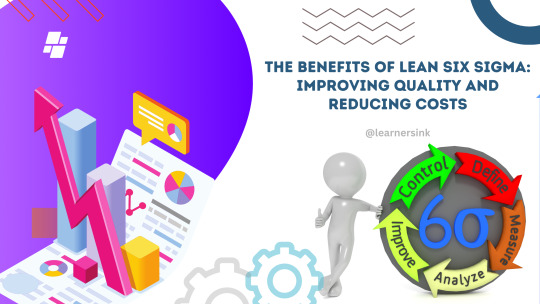#SixSigmaMethodologies
Explore tagged Tumblr posts
Text
In the fast-paced and competitive world of manufacturing, efficiency and quality are paramount. Quality control is crucial in manufacturing, and Lean Six Sigma enhances this aspect with lean-based ERP software.
Customer satisfaction drives business success. Manufacturing ERP software with Lean Six Sigma enhances this. Discover how integrating these methodologies with your ERP system can lead to unparalleled efficiency and growth. Contact us today for a consultation!
#CustomizedERPSoftware#LeanInManufacturingIndustry#SixSigmaMethodologies#LeanManufacturing#LeanManagementProduction#LeanSixSigma#BestManufacturingERPSoftware#BenefitOfLeanManagement#SixSigmaInQualityManagement#BenefitsOfUsingERP
0 notes
Text

Six Sigma Black Belt Certification will help you reach your full potential and advance your career! Dive into our guide for a step-by-step journey that includes insights from 'The Certified Six Sigma Black Belt Handbook.' Improve your skills, lead impactful improvement projects, and gain access to new opportunities. Begin your path to excellence today!
#SixSigma#BlackBeltCertification#ProcessImprovement#DMAIC#SixSigmaMethodology#CareerDevelopment#ContinuousImprovement#CertificationGuide#ProfessionalExcellence#LeanSixSigma#QualityManagement
0 notes
Text

Mastering the Four C's of Lean Six Sigma: Clarity, Collaboration, Customer Focus, and Continuous Improvement.
Learn more >>
#LeanSixSigma#QualityManagement#ProcessImprovement#DataAnalysis#Efficiency#ProblemSolving#ContinuousImprovement#BusinessExcellence#LeanThinking#CustomerFocus#Collaboration#ProcessOptimization#PerformanceMetrics#RootCauseAnalysis#QualityControl#OperationalExcellence#StreamliningProcesses#SixSigmaMethodology#WasteReduction#DataDrivenDecisions#project management#pmpcertifiction
1 note
·
View note
Text
Do You Know Lean/Six Sigma Methodologies?

When implementing Lean/Six Sigma methodologies, there are several common mistakes that people make.
Here are some of them and suggestions on how to avoid these pitfalls:
Lack of leadership commitment: One of the biggest mistakes is when leaders fail to fully commit to the Lean/Six Sigma implementation. Without top-level support and involvement, it becomes challenging to drive the necessary changes. To avoid this, leaders should actively participate in the implementation process, communicate the importance of Lean/Six Sigma to the organization, and allocate necessary resources for its success.
Not focusing on the customer: Lean/Six Sigma aims to improve customer satisfaction by eliminating waste and reducing defects. However, some organizations make the mistake of not aligning their efforts with customer needs and expectations. To prevent this, it's crucial to have a clear understanding of customer requirements, collect feedback, and prioritize improvement initiatives that directly impact customer value.
Overlooking cultural aspects: Implementing Lean/Six Sigma requires a cultural shift within the organization. People may resist change or feel threatened by the new processes. Neglecting the cultural aspect can hinder progress. To address this, organizations should invest in change management activities, provide training and education on Lean/Six Sigma principles, involve employees in the improvement process, and celebrate successes to build a culture of continuous improvement.
Focusing solely on tools and techniques: Lean/Six Sigma provides a range of tools and techniques to identify and solve problems. However, some organizations make the mistake of overemphasizing the tools without understanding the underlying principles. To avoid this, it's important to ensure that employees receive proper training on Lean/Six Sigma principles and philosophy, enabling them to apply the right tools effectively in different situations.
Continue reading Do You Know Lean/Six Sigma Methodologies?
#sixsigmatraining#sixsigmacertification#sixsigmamethodology#sixsigmabenefits#sixsigmablackbelt#gravitexgenesys
0 notes
Text
Growth isn’t just a goal in today’s competitive business environment; it’s essential to survival and success. Lean manufacturing methodology focuses on eliminating waste, optimizing workflows, and maximizing value delivery to customers.
By leveraging technology such as sales CRM or ERP, businesses can automate repetitive tasks, streamline communication channels, and make data-driven decisions.
#BestManufacturingERPSoftware#LeanManufacturing#BenefitsOfUsingERP#SalesCRM#BestSalesCRMSoftware#5sLeanManufacturing#LeanManagementProduction#SixSigmaMethodologies#BenefitsOfLeanSixSigma#CustomizedERPSoftware
0 notes
Text
Achieving Excellence: A Comprehensive Guide on How to Get Six Sigma Black Belt Certified
Introduction:
In today's competitive business environment, organizations are constantly looking for ways to improve their processes, reduce defects, and increase overall efficiency. Six Sigma methodologies have emerged as a powerful tool for achieving these goals, with the Six Sigma Black Belt certification representing the pinnacle. In this blog post, we will look at the process of how to get Six Sigma Black Belt certified, focusing on key steps and resources, including insights from "The Certified Six Sigma Black Belt Handbook" third and fourth editions.
I. Understanding the Six Sigma Black Belt Certification:
A. What is Six Sigma?
Six Sigma is a data-driven approach to reducing defects, improving processes, and optimizing overall business performance. It uses a structured methodology called DMAIC (Define, Measure, Analyze, Improve, Control) to drive continuous improvement.
B. Importance of Six Sigma Black Belt Certification:
Six Sigma Black Belt certification indicates a high level of proficiency in implementing Six Sigma methodologies. Holders of this certification play a critical role in leading and managing improvement projects within an organization, greatly contributing to its success.
II. Key Steps to Become Six Sigma Black Belt Certified:

A. Educational Background and Prerequisites:
1.Have a relevant degree or work experience in a related field.
2. Learn Six Sigma concepts through introductory courses.
B. Gain Work Experience:
1.Gain hands-on experience with process improvement projects.
2. Work on Green Belt projects to gain a practical understanding of Six Sigma.
C. Formal Six Sigma Training:
1. Enroll in a certified Six Sigma Black Belt training program.
2. Select a reputable training provider with experienced instructors.
D. Preparation for the Certification Exam:
1.Use the third edition of "The Certified Six Sigma Black Belt Handbook" for in-depth study.
2. Supplement your studies with additional resources and practice tests.
III. The Certified Six Sigma Black Belt Handbook: Third Edition:
A. Overview of the Handbook:
1.T.M. Kubiak and Donald W. Benbow wrote the third edition, which is a comprehensive guide to Black Belt certification.
2. Concentrates on core Six Sigma concepts, tools, and methodologies.
B. Utilizing the Handbook for Exam Preparation:
1. Understand the DMAIC process in detail.
2. Discover statistical tools and techniques for data analysis.
3. Investigate real-world case studies and examples to gain practical insights.
IV. The Certified Six Sigma Black Belt Handbook: Fourth Edition:
A. Introduction to the Fourth Edition:
1. The fourth edition, authored by T.M. Kubiak, Donald W. Benbow, and H. Fred Walker, builds on the success of its predecessor.
2. Reflects current industry trends and best practices.
B. Examining Updated Content:
1. Investigate new case studies and examples that reflect contemporary challenges.
2. Use the handbook to gain a deeper understanding of advanced Six Sigma concepts.
V. Exam Day Strategies:
A. Time Management:
1. Familiarize yourself with the exam structure and time constraints.
2. Prioritize questions and use time wisely.
B. Reference Materials:
1.Bring essential reference materials, such as "The Certified Six Sigma Black Belt Handbook."
2. Use the handbook for quick reference during the exam.
Conclusion How to be Six Sigma Black Belt certified is a significant accomplishment that necessitates dedication, practical experience, and extensive preparation. "The certified six sigma black belt handbook fourth edition" and “The certified six sigma black belt handbook third edition” is an invaluable resource for aspiring candidates, offering comprehensive insights and practical knowledge. Individuals can successfully pursue Six Sigma Black Belt certification and contribute significantly to organizational excellence by following the steps outlined and utilizing these authoritative resources.
#SixSigma#BlackBeltCertification#ProcessImprovement#DMAIC#SixSigmaMethodology#CareerDevelopment#ContinuousImprovement#CertificationGuide#ProfessionalExcellence#LeanSixSigma#QualityManagement
0 notes
Text

Embark on the journey to become a Six Sigma Green Belt certified professional and advance your career! Our guide includes step-by-step instructions, accredited training programs, and resources such as the Certified Six Sigma Green Belt Handbook. Improve your skills, lead successful projects, and stand out in quality management. Begin your path to success now.
#SixSigma#GreenBeltCertification#ProcessImprovement#QualityManagement#DMAIC#SixSigmaMethodology#CareerDevelopment#ContinuousImprovement#CertificationGuide#ProfessionalGrowth#ProjectManagement
0 notes
Text
Mastering Excellence: A Comprehensive Guide on How to Become Six Sigma Green Belt Certified
Introduction:

In the world of quality management and process improvement, obtaining Six Sigma Green Belt certification is a significant achievement. This certification not only boosts your professional credibility, but it also provides you with the tools and methodologies needed to make a significant impact on organizational efficiency. In this blog post, we will look at the steps of how to get Six Sigma Green Belt certified professional, highlighting key points and referring to the Certified Six Sigma Green Belt Handbook Second Edition.
Understanding Six Sigma Green Belt Certification:
Before we get into the certification process, let's define Six Sigma and Green Belt certification. Six Sigma is a set of techniques and tools for process improvement that seek to reduce defects and variations in manufacturing and business processes. The Green Belt certification denotes a medium level of expertise, indicating an individual's ability to lead and implement process improvement initiatives.
How to Get Six Sigma Green Belt Certified:
1. Understand the Basics of Six Sigma: To begin the journey toward Six Sigma Green Belt certification, it is critical to have a thorough understanding of the Six Sigma methodology. Learn about key concepts such as DMAIC (Define, Measure, Analyze, Improve, Control), statistical analysis, and process improvement techniques.
2. Choose an Accredited Training Program: Enroll in a reputable Six Sigma Green Belt training course. Look for courses approved by reputable organizations such as the International Association for Six Sigma Certification (IASSC) or the American Society for Quality (ASQ). These programs usually cover the core tools, techniques, and methodologies outlined in the Certified Six Sigma Green Belt Handbook.
3. Attend Training and Complete the Coursework: Actively participate in training sessions and complete all assigned coursework. This will cover both theoretical and practical aspects of Six Sigma, allowing you to apply your knowledge in real-world scenarios.
4. Hands-On Project Work: Hands-on project experience is an important part of the Six Sigma Green Belt certification process. You will be responsible for leading a process improvement project using the DMAIC methodology, guided by a certified Six Sigma Black Belt or Master Black Belt. This hands-on experience is invaluable and ensures that you can apply Six Sigma principles in a real-world organizational setting.
5. Study the Certified Six Sigma Green Belt Handbook: The Certified Six Sigma Green Belt Handbook, Second Edition is a comprehensive resource that covers all Six Sigma concepts in depth. Use this handbook as a resource for your training and project work. It provides valuable insights, case studies, and practical tips to help you better understand and apply Six Sigma principles.
6. Prepare for the Certification Exam: Most certification programs end with a formal exam. Prepare thoroughly by using study materials, practice exams, and knowledge from the handbook. The exam will assess your understanding of Six Sigma concepts as well as your ability to apply them in a variety of scenarios.
7. Pass the Certification Exam: Passing the certification exam is the final step toward becoming a Six Sigma Green Belt certified professional. Achieving this milestone validates your ability and willingness to contribute to process improvement initiatives within your organization.
Conclusion: How to become Six Sigma Green Belt certified, you must be committed to continuous improvement and master the Six Sigma principles. By following the steps outlined, utilizing accredited training programs, and consulting the Certified Six Sigma Green Belt Handbook, you can confidently navigate the certification process and significantly contribute to the success of your organization's process improvement initiatives. With Six Sigma Green Belt certified professional, you can embrace the journey, apply what you've learned, and take your career to the next level.
#projectmanagement#SixSigma#GreenBeltCertification#ProcessImprovement#QualityManagement#DMAIC#SixSigmaMethodology#CareerDevelopment#ContinuousImprovement#CertificationGuide#ProfessionalGrowth#ProjectManagement#ASQ#IASSC
0 notes
Text
Navigating the Path to Excellence: A Comprehensive Guide How to Get Six Sigma Green Belt Certified
Introduction
Organizations are constantly looking for ways to improve efficiency and minimize defects in their processes in today's dynamic and competitive business environment. This pursuit has resulted in the widespread use of Six Sigma methodologies, with Six Sigma Green Belt Certification emerging as a key credential for professionals seeking to lead process improvement initiatives. In this blog, we'll look at the steps and resources required for how to become six sigma green belt certified, using information from the "Certified Six Sigma Green Belt Handbook, Second Edition."
Understanding Six Sigma: A Brief Overview
Before beginning the journey toward six sigma green belt certified professionals, it is critical to understand the fundamental concepts of Six Sigma. Six Sigma is, at its core, a data-driven approach to process improvement that aims to reduce variations and defects in organizational processes. The methodology is based on a set of tools and techniques that enable professionals to make informed decisions and achieve measurable results.

The Certified Six Sigma Green Belt Handbook, Second Edition
The "Certified Six Sigma Green Belt Handbook, Second Edition" is an excellent resource for those pursuing Six Sigma Green Belt certification. This handbook, written by Roderick A. Munro, Govindarajan Ramu, and Daniel J. Zrymiak, is a comprehensive guide that adheres to the American Society for Quality (ASQ) Body of Knowledge. It covers important topics such as statistical analysis, process improvement methodologies, and the use of Six Sigma tools.
Step-by-Step Guide to Six Sigma Green Belt Certification
1. Education and Training:
Enrolling in a reputable Six Sigma Green Belt training program is the first step toward certification. Online courses, in-person training sessions, and study materials such as the "Certified Six Sigma Green Belt Handbook" are helpful in laying the groundwork.
2. Practical Experience:
Theory on its own is insufficient. Aspiring Green Belts should apply Six Sigma principles to real-world projects to truly understand them. Practical experience is an essential component of the certification process, allowing professionals to hone their process improvement skills.
3. Green Belt Project:
A Six Sigma Green Belt project is frequently required for certification programs. This practical project demonstrates the candidate's ability to apply Six Sigma methodologies to achieve tangible results within an organization.
4. Exam Preparation:
Thorough preparation is required for certification exam success. During this stage, the "Certified Six Sigma Green Belt Handbook" is an invaluable companion, providing detailed insights into the exam topics such as statistical analysis, process mapping, and hypothesis testing.
5. Taking the Certification Exam:
Candidates should schedule and take the certification exam if they have a solid understanding of Six Sigma principles and practical experience. The exam, which frequently includes multiple-choice questions and practical scenarios, evaluates the candidate's ability to effectively apply Six Sigma concepts.
6. Obtaining Certification:
Passing the exam results in the coveted Six Sigma Green Belt certification. Recognized certifying bodies, such as ASQ, validate the achievement, granting professionals a credential indicating their expertise in process improvement.
7. Maintaining Certification (Optional):
Some certifying bodies may require ongoing professional development to ensure that certified individuals are up to date on the latest Six Sigma advancements. Completing Continuing Education Units (CEUs) or taking refresher courses may be required.
A six sigma green belt certified professional provides access to a plethora of opportunities within organizations dedicated to continuous improvement. Green Belt professionals are prepared to lead projects, analyze data, and collaborate with cross-functional teams. They are critical to driving organizational success by identifying and implementing improvements that improve efficiency and quality.
Conclusion
Obtaining a Six Sigma Green Belt certification is a rewarding journey that requires dedication, practical application, and a thorough understanding of Six Sigma principles. The "Certified Six Sigma Green Belt Handbook, Second Edition" is an invaluable resource for professionals, guiding them through the complexities of the certification process. Aspiring Green Belts can position themselves as positive change agents within their organizations by combining education, practical experience, and exam preparation. The demand for skilled Six Sigma practitioners remains high as the business landscape evolves, making the journey toward Six Sigma Green Belt certification a strategic investment in one's career.
#SixSigmaGreenBelt#CertificationGuide#ProcessImprovement#SixSigmaMethodology#ProfessionalDevelopment
0 notes
Text

Discover the Transformative Magic of Lean Six Sigma: Maximizing Quality while Minimizing Costs! 🌟💡💲 Read>>
#LeanSixSigma#QualityImprovement#CostReduction#BusinessOptimization#ProcessEfficiency#ContinuousImprovement#OperationalExcellence#DataDrivenDecisions#ProductivityBoost#LeanManagement#SixSigmaMethodology#StreamliningProcesses#WasteElimination#ROIEnhancement#PerformanceExcellence#ProblemSolving#QualityControl#ProcessOptimization#CostSavings#BusinessTransformation#pmp training#pmpcertifiction#project management#pmp certification#pmp online#pmpcertificationtraining#projectmanagement#pmp exam#pmp#scrum
1 note
·
View note